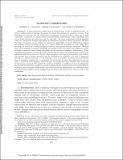| dc.contributor.author | Canonne, Clément L | |
| dc.contributor.author | Gouleakis, Themis | |
| dc.contributor.author | Rubinfeld, Ronitt | |
| dc.date.accessioned | 2021-10-27T20:08:57Z | |
| dc.date.available | 2021-10-27T20:08:57Z | |
| dc.date.issued | 2018 | |
| dc.identifier.uri | https://hdl.handle.net/1721.1/134748 | |
| dc.description.abstract | © 2018 Society for Industrial and Applied Mathematics. In many situations, sample data is obtained from a noisy or imperfect source. In order to address such corruptions, this paper introduces the concept of a sampling corrector. Such algorithms use structure that the distribution is purported to have, in order to allow one to make “on-the-fly” corrections to samples drawn from probability distributions. These algorithms then act as filters between the noisy data and the end user. We show connections between sampling correctors, distribution learning algorithms, and distribution property testing algorithms. We show that these connections can be utilized to expand the applicability of known distribution learning and property testing algorithms as well as to achieve improved algorithms for those tasks. As a first step, we show how to design sampling correctors using proper learning algorithms. We then focus on the question of whether algorithms for sampling correctors can be more efficient in terms of sample complexity than learning algorithms for the analogous families of distributions. When correcting monotonicity, we show that this is indeed the case when also granted query access to the cumulative distribution function. We also obtain sampling correctors for monotonicity even without this stronger type of access, provided that the distribution be originally very close to monotone (namely, at a distance O(1/log2 n)). In addition to that, we consider a restricted error model that aims at capturing “missing data” corruptions. In this model, we show that distributions that are close to monotone have sampling correctors that are significantly more efficient than achievable by the learning approach. We consider the question of whether an additional source of independent random bits is required by sampling correctors to implement the correction process. We show that for correcting close-to-uniform distributions and close-to-monotone distributions, no additional source of random bits is required, as the samples from the input source itself can be used to produce this randomness. | |
| dc.language.iso | en | |
| dc.publisher | Society for Industrial & Applied Mathematics (SIAM) | |
| dc.relation.isversionof | 10.1137/16M1076666 | |
| dc.rights | Article is made available in accordance with the publisher's policy and may be subject to US copyright law. Please refer to the publisher's site for terms of use. | |
| dc.source | SIAM | |
| dc.title | Sampling Correctors | |
| dc.type | Article | |
| dc.contributor.department | Massachusetts Institute of Technology. Computer Science and Artificial Intelligence Laboratory | |
| dc.relation.journal | SIAM Journal on Computing | |
| dc.eprint.version | Final published version | |
| dc.type.uri | http://purl.org/eprint/type/JournalArticle | |
| eprint.status | http://purl.org/eprint/status/PeerReviewed | |
| dc.date.updated | 2019-07-03T13:51:16Z | |
| dspace.orderedauthors | Canonne, CL; Gouleakis, T; Rubinfeld, R | |
| dspace.date.submission | 2019-07-03T13:51:16Z | |
| mit.journal.volume | 47 | |
| mit.journal.issue | 4 | |
| mit.metadata.status | Authority Work and Publication Information Needed | |
